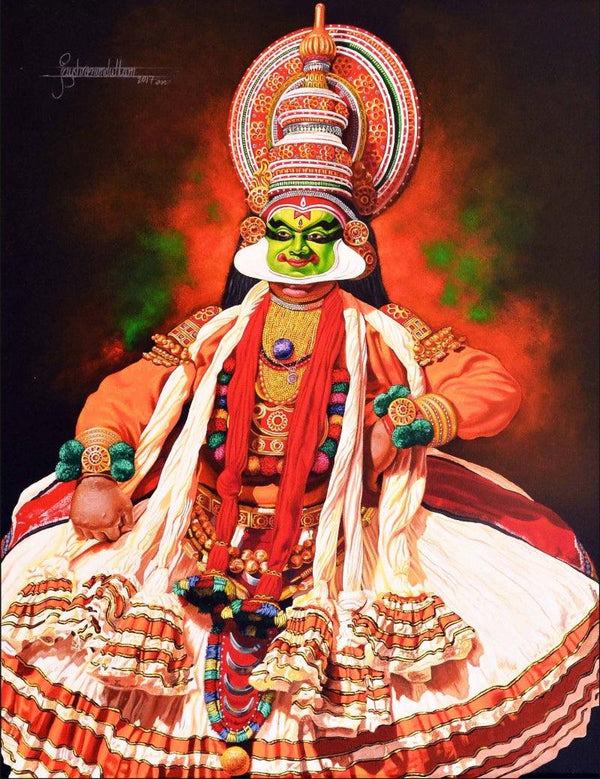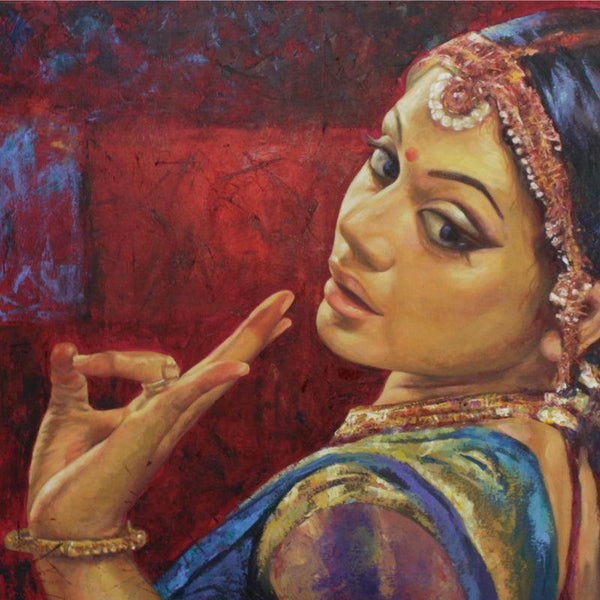South Indian dance forms are an expression of its rich cultural and artistic legacy. Not merely entertainment forms, these dances express spiritual devotion, storytelling and the joyous celebration of life through movement and art. Paintings depicting these dance forms capture their beauty as well as capturing its emotions embedded within every move. We will examine some significant South Indian dance forms here along with their history, meaning and how they have been immortalized through painting and other mediums.
Bharatanatyam: the Dance of God.
Origin and Development: Bharatanatyam, hailing from Tamil Nadu, is one of India's oldest classical dance forms. Originating as temple dances performed by Devadasis (temple dancers) it has undergone transformation over the ages while remaining true to its core essence.
Meaning and Significance:
Bharatanatyam dance is an artistic blend of Bhava (expression), Raga (melody), Tala (rhythm) and Natya (drama). This tradition draws deeply from Hindu mythology and spirituality, often depicting scenes from stories like Ramayana and Mahabharata epics. Bharatanatyam serves as an artful way of devotional storytelling with every gesture and expression carrying profound meanings.
Religion:
This dance form often alludes to gods such as Shiva (often depicted as Nataraja, or cosmic dancer), Vishnu and various goddesses as points of worship in its performances; many performances have even been dedicated to them.
Paintings Depicting Bharatanatyam:
Paintings depicting Bharatanatyam dancers can capture intricate hand gestures, expressive faces and dynamic postures of these talented dancers perfectly. One popular example is "Shiva as Nataraja," depicting Shiva dancing cosmically. As another classic example, Raja Ravi Varma, one of India's premier painters has depicted many scenes involving Bharatanatyam featuring dancers dressed in their traditional attire complete with ornate jewelry and colorful costumes - something few other Indian painters could do justice to!

Kathakali: A Visual Storyteller
Kathakali, which originated in Kerala, is best known for its dramatic makeup, intricate costumes, and powerful storytelling. Over time it evolved from temple rituals and classical art forms into its current dance drama form by the 17th century.
Meaning and Significance:
Kathakali combines dance, drama and music to tell stories primarily drawn from Mahabharata and Ramayana scriptures. Performers use exaggerated facial expressions, hand gestures (mudras) and body movements to portray these stories onstage.
Kathakali performances often depict scenes from the lives of gods and goddesses from Hindu mythology, including Krishna, Rama and their demon counterparts as focal figures in many performances.
Paintings Depicting Kathakali: Kathakali dancers stand out with their striking makeup, elaborate headgear, and expressive eyes in paintings depicting Kathakali performances, often shown through mural paintings in Kerala which capture vivid colors and dramatic poses of its dancers.
Kuchipudi: the dance of grace
Origin and Development:
Kushchipudi originates in Andhra Pradesh's Kuchipudi village and can be traced back as far as 17th Century. While initially only male Brahmin dancers performed it, over time this art form has expanded and now also incorporates female dancers - becoming one of the premier classical forms in Andhra Pradesh today.
Meaning and Significance:
Kuchipudi dance uses fast rhythms, intricate footwork and expressive gestures to tell stories from Hindu mythology through both pure (nritta) and expressive dance (nritya).
Many Kuchipudi performances pay homage to God or one of His many attributes, especially Krishna who often appears in performances as an iconic figure whose playful yet romantic adventures make for popular themes in dance performances. Furthermore, ritualistic invocations and prayers often accompany this form.
Paintings Depicting Kuchipudi:
Artworks depicting Kuchipudi dancers showcase their graceful movements, traditional costumes and expressive faces to bring this ancient Indian form of dance alive on canvas. Contemporary artists like Bapu have created iconic images showcasing this fluid art form's elegance and fluidity.
Mohiniyattam: The Dance of the Enchantress
Mohiniyattam is another dance form from Kerala thought to have originated around 1600. Taking its name from Mohini, one of Vishnu's female avatars, this graceful form is known for its graceful yet swaying movements and is named for Mohini, whom people refer to as the Enchantress of Vishnu.
Meaning and Significance:
Mohiniyattam dance is distinguished by gentle yet rhythmic movements resembling palm leaves swaying in a breeze. Performed solely by women, Mohiniyattam often depicts love or devotion themes in its choreography.
Representations of God:
Contemporary dance often revolves around stories about Krishna and Vishnu. Dancers use this dance form to express various feelings related to romantic or devotional themes.
Paintings Depicting Mohiniyattam:
Mohiniyattam dancers can be depicted beautifully through paintings that capture their serene yet graceful movements. Both traditional Kerala mural paintings and contemporary artworks often show Mohiniyattam dancers in their signature white and gold attire - exuding elegance and poise.
Bhagavata Mela: The Divine Play
Origin and Evolution: Bhagavata Mela hailing from Tamil Nadu is a traditional dance-drama which blends elements of classical dance with theater performance. Held annually as part of a religious festival in Melattur village.
Meaning and Significance: Bhagavata Mela is dedicated to honoring Lord Narasimha, an avatar of Vishnu. Performances involve dance, music, drama and storytelling from Hindu mythology.
References to God: At Bhagavata Mela, its focus is to celebrate Lord Narasimha with devotion. Stories performed often focus on episodes from Puranas that detail Vishnu's avatars as central themes of devotional stories performed during this festival.
Paintings Depicting Bhagavata Mela:
Paintings depicting Bhagavata Mela dancers capture their traditional costumes, elaborate headgear, and dramatic expressions perfectly. Artwork depicting these performances often emphasizes their devotional aspect and highlight spiritual links between performers and deities.
Conclusion
South Indian dance forms are an intricate blend of artistry, spirituality, and storytelling that offers something for everyone to appreciate. Paintings depicting these dances serve as visual narratives that complement their dynamic movements and rich traditions - from Bharatanatyam's divine expressions and Kathakali's dramatic storytelling to Kuchipudi and Mohiniyattam's graceful elegance and Bhagavata Mela's devotional fervor - each form has its place within South India's rich cultural fabric. These paintings not only depict these dances visually but they serve as timeless tributes to Sou India's rich cultural tapestries while honoring Sou India's lasting legacies.










